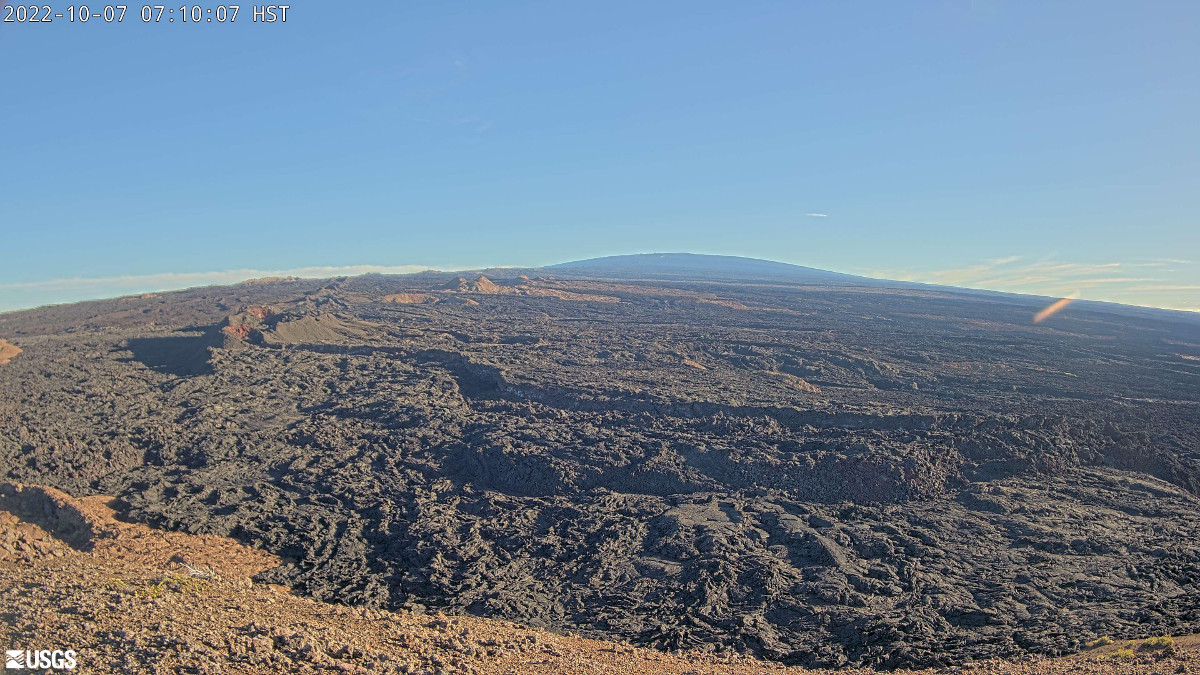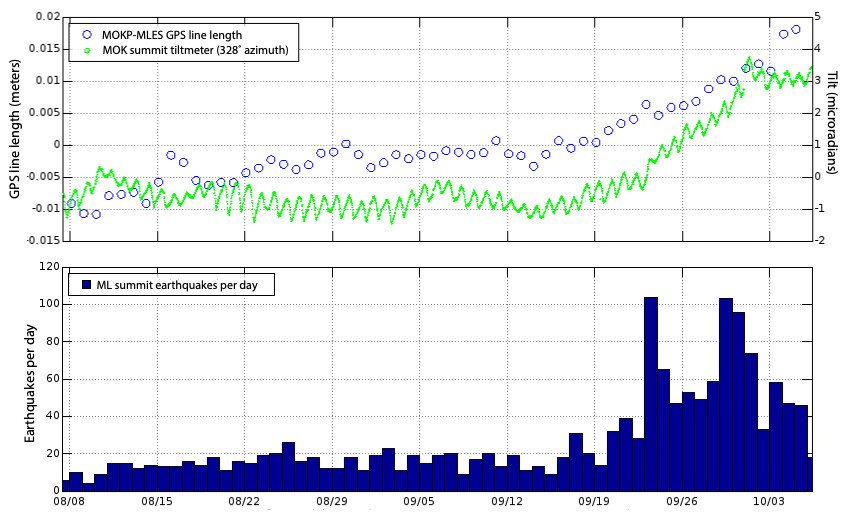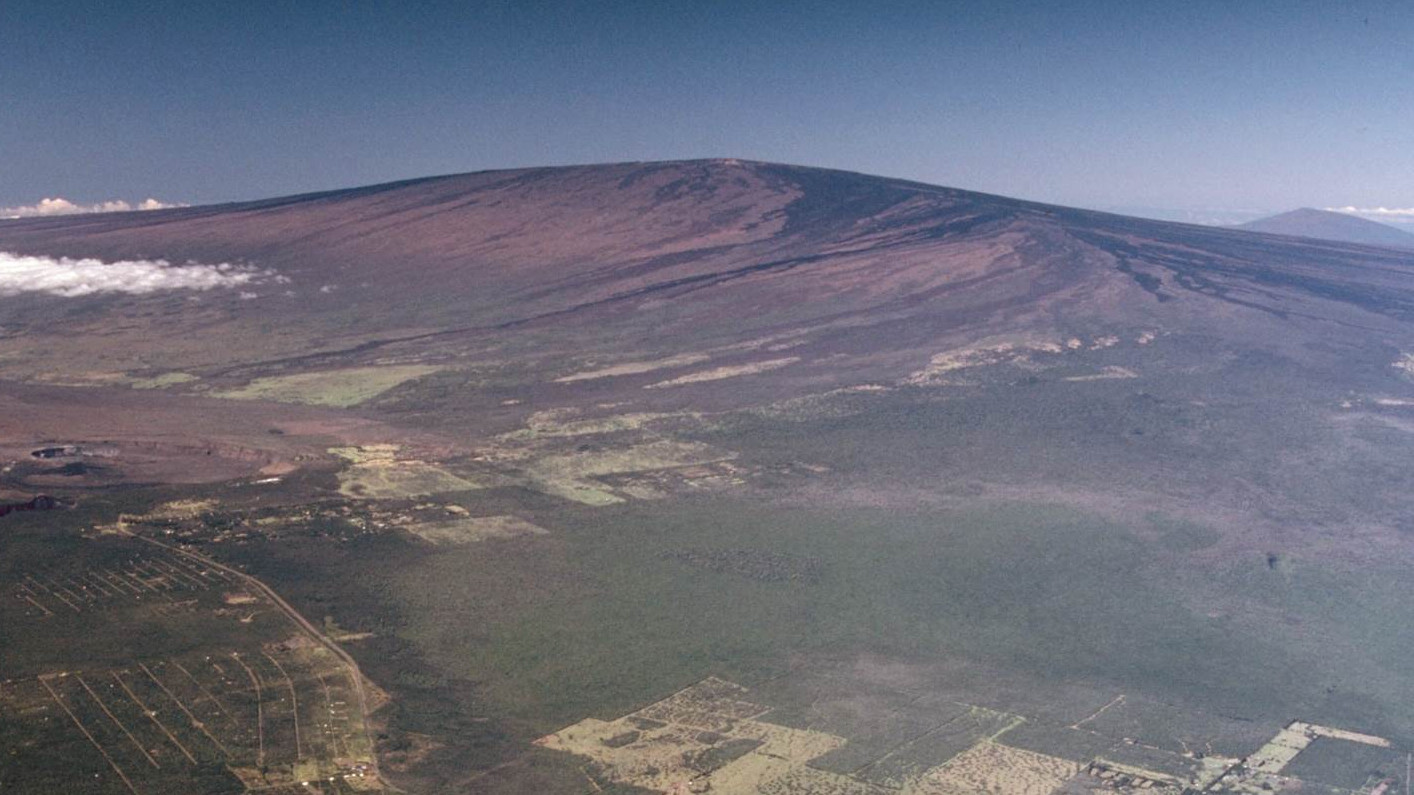
USGS: “This image is from a research camera positioned on a cone in Mauna Loa’s Southwest Rift Zone in Hawaiʻi Volcanoes National Park. The camera looks northeast (upslope), focusing on the middle part of the Southwest Rift Zone. The volcano’s summit is at upper right.”
- This week’s Volcano Watch article, written by U.S. Geological Survey Hawaiian Volcano Observatory scientists and affiliates, focuses on Mauna Loa unrest.
- On October 5, the USGS Hawaiian Volcano Observatory began providing daily updates on Mauna Loa activity, reflecting a heightened level of unrest. There are no signs of an imminent eruption at this time, and the USGS Volcano Alert Level / Color Code remains at ADVISORY / YELLOW.
- As a precautionary measure, Hawai‘i Volcanoes National Park is closing the Mauna Loa summit backcountry until further notice.
From this week’s Volcano Watch, written by HVO research geophysicist Ingrid Johanson:
The last eruption of Mauna Loa occurred in 1984 and began in a style typical of the volcano. At 10:55 p.m. on March 24, 1984, the rate of earthquakes under Mauna Loa started to rapidly pick up. While rates of earthquakes were already above normal, they quickly rose to 2-3 earthquakes per minute.
By 11:30 p.m., strong seismic tremor had begun, indicating that magma was moving underground and getting close to the surface. The eruption began at Mauna Loa’s summit at 1:30 a.m. on March 25.
The rapid onset of extreme unrest leading to eruption in 1984 is typical of the Mauna Loa eruptions that have been observed in the last two centuries. In addition to rapid onset, eruptions that migrate down either of Mauna Loa’s rift zones tend to be high volume and resulting lava flows can move quickly from their eruptive vents downslope toward the ocean. As described in a March 11, 2022, “Volcano Watch” article, lava flows moving down the steep slopes of South Kona can reach the ocean as soon as 3-4 hours after the start of a rift eruption. The combination of rapid onset, large lava volumes, and fast lava flows can make Mauna Loa eruptions particularly hazardous.
The technology we use to monitor volcanoes has changed a lot since 1984. Paper seismograms, hand-collected survey data, and visual observations have given way to digital broadband seismic data, continuous GPS measurements, and a network of webcams. This means we have a lot more detail about Mauna Loa’s current period of unrest than has ever been possible before. Nonetheless, it is still possible for the situation to change rapidly and it is difficult to forecast when that might happen.
Mauna Loa’s current episode of unrest began in late 2014 with an increase in the rates of inflationary deformation and seismicity. These rates waned in 2017-2018, but began increasing again in 2019 and have remained somewhat steady since then, with earthquake rates of about 20 per day. A noticeable seismic swarm occurred from late January through mid-April 2021 and was accompanied by changes by ground surface tilt recorded by a summit tiltmeter. This was an unprecedented observation that indicated magma had been getting closer to the surface. Another short swarm and tilt event was observed in early August 2022.

USGS: “Hawaiian Volcano Observatory Mauna Loa monitoring data showing increased ground deformation rates (top) and earthquake rates (bottom) from August 8 through October 5, 2022. The distance (line length) between GPS stations MOKP and MLES (blue circles) lengthened by about 2 cm (less than 1 inch), indicating that Mauna Loa is expanding as more magma accumulates beneath the surface. MOKP is located just Northwest of Mokuʻāweoweo (Mauna Loa’s summit caldera) and MLES is located on Mauna Loa’s upper southeast flank. Tiltmeter measurements (green line) also show increased ground motions (the daily oscillations in tilt are due to local heating and cooling cycles). There were less than 20 earthquakes per day (blue bars) from early August through mid-September. The rate increased to about 40-50 earthquakes per day over the past two weeks, with peaks of over 100 earthquakes per day on September 23rd and 29th. USGS plots.”
The current and ongoing swarm began on September 22, 2022, and marked the start of a persistent increase in earthquake rate at Mauna Loa’s summit. It rose from about 20 per day to 40-50 per day, with two days getting as high as 100 per day. Shallow (less than about 2 miles or 3 kilometers depth) opening of magma pathways has also been detected as an inflationary tilt event. However, the bulk of Mauna Loa’s deformation is still due to deeper processes (greater than about 2 miles or 3 kilometers depth) that have been occurring since 2019.
Other signals, such as seismic tremor, that would indicate that an eruption is imminent, have not been observed. However, due to the sustained high level of earthquakes, the Hawaiian Volcano Observatory (HVO) has begun issuing daily updates on Mauna Loa’s status that are available on the USGS website.
This uptick in activity is a good reminder to be prepared for a volcanic eruption, whether you live on the flanks of Mauna Loa or anywhere else on the Island of Hawaiʻi.
The steps to be prepared for a volcanic eruption are the same as for many other hazards and is part of “All Hazards” preparedness. It includes putting together a “go bag” with essentials in the case of quick evacuation, as well as a communication plan among your family members, and knowing how to get updated emergency information. More information is available in a March 11, 2022, “Volcano Watch” article that focused on lava flow hazards from Mauna Loa. Additionally, Hawaiʻi County Civil Defense has resources on their website to help you create an “All Hazards” plan for your family.


by Big Island Video News7:34 am
on at
STORY SUMMARY
HAWAIʻI ISLAND - Following a recent trend of heightened unrest under Mauna Loa volcano, scientists explain how quick changes can lead to an eruption in the future.